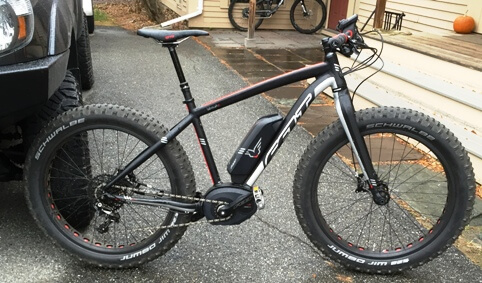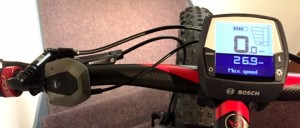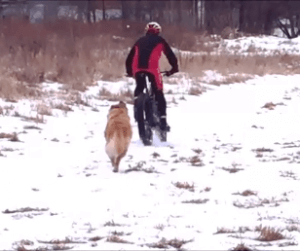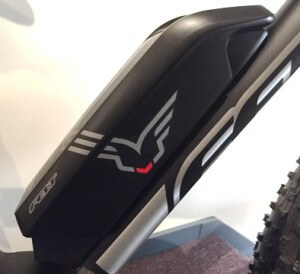Felt LEBOWSKe Electric Fat Bike – Same Workout. Twice the Speed. Twice the Fun.
I’ll admit it, I’m a bit of a weight weenie when it comes to my bicycles. My road bikes usually weigh 15 lbs or less, my Moots Rogue YBB mountain bike is about 22 lbs, and the full suspension mountain bike I’m planning at the moment will be in the 25 lbs range. This being said, I’m going to state as fact that you have absolutely no idea just how much fun riding a bike in the winter can be until you get on an almost 50 lbs Felt LEBOWSKe electric Fat Bike.
 What is the Felt LEBOWSKe electric Fat Bike?
What is the Felt LEBOWSKe electric Fat Bike?
The Felt LEBOWSKe is a hydroformed aluminum Fat Bike equipped with Bosch eDrive multi-level electric assist. Now, before you say anything about electric assist being cheating or for people not wanting a workout, hear me out. While electric assist bikes serve all sorts of great purposes – from making commutes more reasonable to keeping people on bikes who would otherwise have to stop riding – minimizing your aerobic effort need not be one of the benefits (unless you want it to). You can get your heartrate up just as high with electric assist on as off on the Felt LEBOWSKe, you just move a heck of a lot faster in the process with it engaged.
Why get a Felt LEBOWSKe electric Fat Bike?
A picture (video) can tell a thousand words – hit play.
The first and third sequences in the video are without any electric assist and the second and last are of the electric assist at third (Sport) of four assist levels. I think the proximity of Coby the dog to the bike in the last two sequences says it all. Did you even see her in the second to last sequence (when electric assist was off)? She is so far ahead of me that it is easy to miss her. Note where she is in the last sequence when electric assist was activated… Electric assist can even be appreciated by canines.
At a given exertion level, how much faster is the Felt LEBOWSKe electric Fat Bike than a standard Fat Bike?
 The Bosch eDrive system on the Felt LEBOWSKe electric Fat Bike has five settings – “Off”, “Eco”, “Tour”, “Sport” and “Turbo”. This means you can select just how much faster you want the bike to be at a given level of exertion. To test this, I ran some informal laps around a field in three different settings.
The Bosch eDrive system on the Felt LEBOWSKe electric Fat Bike has five settings – “Off”, “Eco”, “Tour”, “Sport” and “Turbo”. This means you can select just how much faster you want the bike to be at a given level of exertion. To test this, I ran some informal laps around a field in three different settings.
Lap 1: The first lap was in “Eco” mode. You can clearly feel the system working in “Eco” mode and I was “plowing” through the snow and making a track in most places on this initial lap. On the long straights I was consistently seeing top maintainable speeds in the 14 mph range. Lap Time: 6:05. Perceived Exertion Level: 80%.
Lap 2: The Second Lap was in the “Off” position; just me, the bike and the gears. The conditions were not easy, but I could make it around and there were places where I was able to get the bike up in the 12 mph range if I was really working at it, but things were usually well below 10 mph even on the straights. There was a very soft off camber hill in the field that I failed to negotiate. My first thought was, “Wow, I didn’t even think about not making it up in “Eco” mode.” Lap Time: 9:10. Perceived Exertion Level: 85%.
Lap 3: The Third Lap was in “Sport” mode, the second from the highest level of assistance and two levels up from “Eco”. “Sport’ mode is a blast. I feel some similar speed sensations to alpine skiing (or road biking) as the wind is in your ears much of the time. With sustainable speeds on the flat straights in the 16-18mph range, there was enough assist in this mode that I actually couldn’t maintain the same exertion rate as I did in “Eco”, but I was still getting a moderate workout. Lap Time: 4:23. Perceived Exertion Level: 70%.
Lap 4: The Fourth Lap was in “Off” position again. This time, the trail was getting a bit more packed. I made it up the little hill this time, but barely as balancing at such low speed and off-camber is quite hard and I need more practice to get better at this. Lap Time: 8:58. Perceived Exertion Level: 85% (I really had to work a t that hill!).
t that hill!).
At this point, the trend was quite clear – I was riding two times as fast in “Sport” mode than “Off” and with lower exertion level while “Eco” assist mode had similar exertion level on the flats to pedaling on my own, but was 30%+ faster and helped make going up hills and through really soft snow significantly more enjoyable. As someone who tends to appreciate speed, the amount of fun I was having riding with electric assist was enhanced markedly.
On a related note, “Turbo” is even faster than “Sport” and the perceived exertion would have gone down further and the speed up even higher (assuming I could hang on through the slush at a top speed above 20 mph!). Hard day or easy, it is really nice to have options.
While I didn’t include it in the test, I actually often find myself in “Tour” mode (between “Eco” and “Sport”). For me, “Tour” seems to guarantee the ability to get a similar physical exertion rate from my body to riding a bike without assistance, but at around double the speed. I call that equation a huge “win-win”.
Isn’t the electric assist on the Felt LEBOWSKe cheating?
If you are racing, sure, an electric assist bike would be cheating. Most of us don’t race though and isn’t having fun a really big part of what riding your bike is supposed to be about? If you can get a really similar workout to what you do on a bike without electric assist, but you get unparalleled exhilaration and can go double the speed, why wouldn’t you want that?
Fat Bikes are a great way to get out and ride all winter long. One great thing about riding a Fat Bike in the winter is that when the Nordic skiing is bad, the Fat Biking is usually at its best. However, if you tend to enjoy speed on a bike (like me), Fat Biking (especially in softer snow) can feel a bit like backcountry Nordic skiing compared to ripping GS turns on alpine skis on well prepped corduroy; backcountry Nordic is a great way to get outside and get a hard workout, but you don’t tend to cover much ground quickly. The Felt LEBOWSKe electric Fat Bike turns riding a Fat Bike, even in softer snow conditions, into more of an alpine ski experience when it comes to speed. However, you can still get that great aerobic workout of Nordic skiing at the same time if you want it. Very impressive and fun indeed.
Felt LEBOWSKe Electric Fat Bike Conclusions
I admit that I deliberated a fair amount before buying a Fat Bike that weighs almost 50 lbs and isn’t cheap at $5800. This being said, I didn’ t have any regrets once I started to ride it. The Felt LEBOWSKe does what a great bike should – makes my riding more fun and helps me ride better than I do on other equipment.
t have any regrets once I started to ride it. The Felt LEBOWSKe does what a great bike should – makes my riding more fun and helps me ride better than I do on other equipment.
The battery pack lasts long enough for fairly lengthy explorations (after my quick 40 minute ride today, it had 4 of 5 bars remaining). Everything on the bike is pretty easy to operate and learn and riding it is unprecedented.
I suspect that I will continue to ride the Felt LEBOWSKe electric bike regularly enough to justify upgrading it with a Rock Shox Bluto suspension fork (as the speed increases, you notice the lack of a shock) and I wouldn’t be surprised if I take it out in the dirt/sand in the summer too. The bike is simply a blast and way more versatile than it may initially appear.
Where Can I Try a Felt LEBOWSKe Electric Fat Bike?
Along with other demo Fat Bikes like the Fatback Rhino, Fatback Skookum, Felt DD10 and Felt DD30, our Waitsfield, VT Fit Werx has a Felt LEBOWSKe available for demo in the field across the road from the shop, up at the great trails of Blueberry Lake (a ten minute drive from the shop), or you can rent it and take it home with you for awhile. If you decide you want one (or any of the other great Fat Bikes we carry from Felt, Fatback, Surly or Moots), we’ll give you up to two days of demo fees towards your new Fat Bike. With advanced reservation, our MA location can often provide a Felt LEBOWSKe demo bike as well.
Contact us at either location if you have questions about the Felt LEBOWSKe, eBike technology or Fat Bikes in general. We’re here to help you enjoy this exciting and fun technology and to make winter on two wheels almost as much fun as summer!

